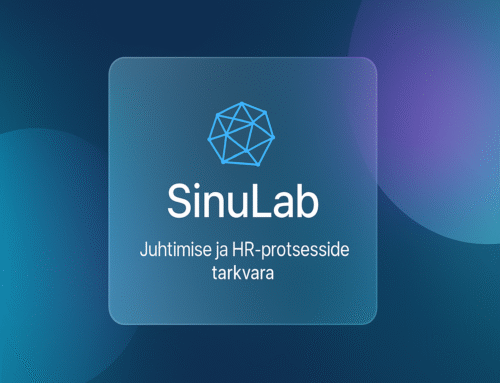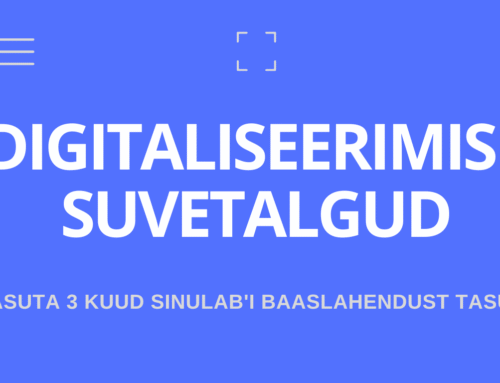The article was published in April 2021 in the journal Personali Praktik. Author Maarit Vabrit-Raadla
This article is written from the point of view of a software provider to highlight the issues and problems we have seen in the last 5 years working with different companies in digitalizing human resources and people management processes.
The article aims in particular to draw attention to the most common problems in order to prevent them where possible.
During the last 5 years, we have come into contact with almost 800 organizations and participated in / advised about 200 companies / organizations. Let us summarize this time in the light of all these experiences.
General view at the organizational level
- Digital capability and readiness
Overall, digital capability and readiness for digitalization are low. Looking at the overall picture of the organization, it is quite common for digit(al)ization to be fragmented. This means either focusing on just one specific topic, such as financial management or production, or adopting so many different smaller digital solutions that the picture has become very colorful and inconspicuous. It can no longer be managed.
- Awareness of Managers
Many managers / owners of SMEs (small and medium-sized enterprises) have not made themselves aware of the importance of digitization, lack a comprehensive long-term vision and largely lack an understanding of what would be needed or possible to digit(al)ize. Mostly limited to accounting software and e-sales channels.
- There is lack of vision and clear responsibility
The lack of a vision for the future also means that the company has not agreed on who will be the leader in digitalization and how the activities will be carried out. Roles and responsibilities are not discussed, everyone and no one is dealing with the topic, and the results seem to be absent or confusing.
The above has often asked me questions, how do such companies ensure business continuity and confidence for employees? How is it possible to manage a company if there is no long-term vision and action plan? And this is not just a question of digital vision, but of the future of the entire organization.
What hinders the digitalization of people & culture area?
Of course, the 11 observations below do not apply to all the companies we have come into contact with. As we have also experienced very positive examples and approaches, it is necessary to point out the opposite in order to draw attention to improving the overall level.
- Personnel work and people management issues are not a priority area in the company, especially in terms of digitalization. Usually, people's topics (excluding payroll) are placed at the end of the line. Although the beautiful slogans that "People are most important to us" are constantly heard by leaders, in reality the focus is on other topics.
- It is very often thought that only payroll and personnel management should be digitalized in HR work. However, during the initial consultations, it almost always becomes clear that the need is wider and also concerns the substantive issues of peaople management and development. Sadly, the awareness of wider perspective is not present and this fragmentes the integrity of digitization and also the Employee experience from the very beginning.
- Digitization is believed to to be activities to find and use the software. Unfortunately, this is a very ungrateful approach, especially in terms of the use of resources. Software is a tool in the digitalization process that helps to manage and systematize data, to carry out processes. The successful implementation and deployment of the software is preceded by the work on expectations-needs mapping, process analysis and many other activities that affect the further deployment and applicability of the software. Weak pre-work, non-compliance and limited digital capabilities can ultimately be costly for the company.
- We have seen the above in organizations where work with people is fragmented . This means that there is no holistic approach and clearly linked activities that contribute to Leadership and employee experience. The focus is on single activities and parts of HR work. For example, recruiting software is sought to make it easier for a recruiter to select candidates, but does not include the tools needed to create an employer branding (eg a career page) or provide a candidate experience throughout the recruitment process up to Onboarding. However, all this should form a comprehensive path.
- We are very often contacted with a request for an offer . On closer communication, it turns out that the HR manager or manager has not yet figured out exactly what he or she wants. He/she says they need everything that makes a job easier but can't formulate what exactly it should be. Therefore we have also provided advice or consultation to such inquirers, simply because Managers/Companies should have an understanding of budgeting and all the different options that one contemporary people software can offer.
- Human resources are often in a situation where they receive little support in terms of IT . This can be due to a lack of IT competencies in the company, a lack of previous exposure to people software, a lack of experience, a focus on hardware and systems administration, or other issues. But managing and discovering alone is often too much and difficult work for HR.
- The previous point can also be an obstacle because many HR people themselves lack digital competencies . What types of software are available and what are the advantages of one or the other (cloud software, desktop software, software on your server). In general, there is also no knowledge of the basis on which the software business logic is built (three-layer structure: data and databases, application interface or business logic, user interface or UI / UX). Ending with the basic security issues that are very important today (such as data encryption, user authentication, data storage, etc.). Not to mention that the HR people themselves, who will start using the software and, if necessary, also support other employees of the company, should be able and interested in working with digital solutions.
- Another major problem is that the company's employees, who should start using the software in the future, often suffer as a result of insufficient preliminary work. As a side note, modern human resources software requires the possibility of self-service and at the same time is an environment for communication and feedback for both managers and employees. Software today is not limited to a small group or individuals, but should be used by the widest possible range of managers and employees, as it is for them to access the information is most critical in time.
Employees suffer from digitalisation, in particular, when decision-makers do not involve representatives of target groups and do not take into account their needs and expectations. In this case, the implementation of the software has always been many times more difficult and took longer, both due to the resistance, and the lack of matching of expectations and needs.
- It takes time to see the benefits of the software . For some reason, it is expected that the benefits of starting to use a software should be immediate, such as tomorrow. However, it is usually the case that in the first year of use, the most important contribution is to get to know the software, adjust the processes, establish permanent usage habits and support the users. The positive effects will start to appear after a while, when the habit has taken root and become part of the work behavior. So initially you should contribute to the implementation and then you can enjoy the results.
- Software is sought and assumed to be suitable only if it fully conforms to existing practices. Unfortunately, the implementation of new software inevitably leads to changes and modifications in processes and accustomed activities . It is often expected that the processes and activities will be easier and faster due to the software, but for that one will have to start doing something differently than has been done so far. You can't be successfulwithout changing the habits.
- HR people somehow fear that the implementation of software will reduce their role and need in the company and they may lose their jobs. This might be also the reason why they do not show interest in digitilizing HRwork. Sadly, they disclaim the need to develop or improve themselves to be a valuable partner for their leader and organization, today and in the future. But, without a capable HR manager who is motivated and aware of the nature of digitalization, no company will be successful in HR and people management area.
Recommendations for the digitalization of the People, Leadership & Culture processes
Preliminary work:
- clearly define the needs and expectations of the organization,
- based on the business vision analyze the future needs (3-5 years)
- analyze the target groups and users , including their digital capabilities and readiness,
- receive the expected budget approval from the management,
- clarify the key security standards required to implement the software.
General indicators to review
- the software can be tested before purchase, for example by conducting a pilot or using an agreed trial period: upload test user data, try different functionalities and understand the logic of the software
- the software has multiple roles with distinct rights and accesses
- the software is easy to use for both administrators and managers / employees
- learning the logic and functionalities of the system does not take long
- understanding what is included in the price of the product
Technical requirements and security
- the software essentially meets your company's security standards
- it is possible to integrate with other software
- Single Sign On (SSO) is supported, for example Active Directory
- the software can be used immediately and does not require any special settings or programming
- personal data is managed and stored in accordance with the law (GDPR), regular backups are made
Software user-friendliness
- the existence of self-service, modern user interface design and user-friendliness
- usability in several languages, if relevant
- technical support and availability of assistance
- product updates are issued twice a year or even more often
In addition to human resource management software, SinuLab also offers digitalization consulting, project management and training to help small and medium-sized businesses select and implement software.





Leave A Comment